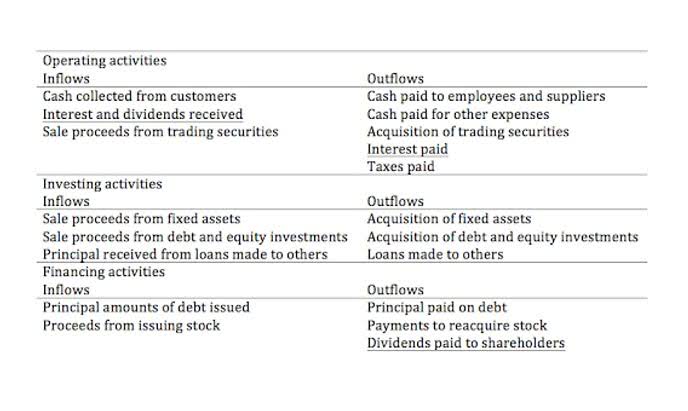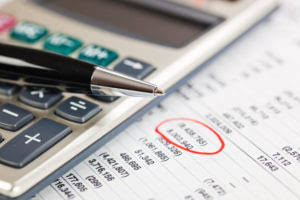
Business owners and entrepreneurs, this is your compass for navigating business performance and fine-tuning your strategies. And if you’re a manager, mastering cash flow statements can elevate your budget management skills, deepen your connections with leadership, and expand your role within the company. A cash flow statement is a financial statement that shows the cash going in and out of a business over a set period. A company’s accounting department keeps track of every transaction that involves cash, such as receiving money when a client pays an invoice or sending money out to make payroll or meet a loan payment. The cash flow statement will not present the net income of a company for the accounting period as it does not include non-cash items which are considered by the income statement. This method measures only the cash received, typically from customers, and the cash payments made, such as to suppliers.

What are the key components of a cash flow statement used in cash flow analysis?

The three types of cash flow are cash flows from operations, cash flows from investing, and cash flows from financing. Cash flow analysis is the process of examining the amount of cash that flows into a company and the amount of cash that flows out to determine the net amount of cash that is held. Once it’s known whether cash flow is positive or negative, company management can look for opportunities to alter it to improve the outlook for the business. Let’s say Acme Company produces a cash flow statement showing the cash flows below. You can go one step further by expanding what’s included in the free cash flow number.
Cash Flow Statement Calculator

The direct method adds up all of the cash payments and receipts, including cash paid to suppliers, cash receipts from customers, and cash paid out in salaries. This method of CFS is easier for very small businesses that use the cash basis accounting method. There are two forms of accounting that determine how cash moves within a company’s financial statements.
Maintains an Optimum Cash Balance
There are various ways to do this, like negotiating extended payment terms with suppliers. This allows you to preserve cash for other operational needs or investment opportunities. These are the day-to-day transactions related to your core business operations. So they found a buyer who is interested in this but he first wants to know check the company’s value is good or not by calculating cash flow from assets. Changes in working capital show the net change of working capital for a specific period of time. You generally read a statement of cash flows from top to bottom, adding or subtracting for each line item to arrive at a total inflow or outflow for each of those 3 categories of cash flows.
Business Valuation
The first step is calculating your company’s operating cash flow (OCF), that is, cash flow from operations. Cash flows are analyzed using the cash flow statement, which is a standard financial statement that reports a company’s cash source and use over a specified period. Corporate management, analysts, and investors use this statement to determine how well a company earns to pay its debts and manage its operating expenses. The cash flow statement is an important financial statement issued by a company, along with the balance sheet and income statement.
- Another important function of the cash flow statement is that it helps a business maintain an optimum cash balance.
- Cash and cash equivalents are consolidated into a single line item on a company’s balance sheet.
- But as you become more familiar with the language of financial statements it may become easier to make sense of them.
- Cash flow statements are important as they provide critical information about the cash inflows and outflows of the company.
- If you do your own bookkeeping in Excel, you can calculate cash flow statements each month based on the information on your income statements and balance sheets.
- In other words, revenues and expenses are recorded when cash is received and paid, respectively.
Interested in automating the way you get paid? GoCardless can help
But it still needs to be reconciled, since it affects your working capital. Depreciation is recorded as a $20,000 expense on the income statement. Since no cash actually left our hands, we’re adding that $20,000 back to cash on hand. Using the cash flow statement example above, here’s a more what is cash flow from assets detailed look at what each section does, and what it means for your business. Since it’s simpler than the direct method, many small businesses prefer this approach. Also, when using the indirect method, you do not have to go back and reconcile your statements with the direct method.
What challenges and limitations should businesses be aware of when conducting cash flow analysis?
The market risk premium is the expected return of the market over the risk-free rate. Calculating the market risk premium involves determining the expected return on a market portfolio and subtracting the risk-free rate. This value reflects the additional compensation investors expect for taking on market risk. Don’t leave your business’s financial success to chance – take action today and secure your company’s future with professional wealth management services. Failing to update cash flow analysis can result in outdated insights and ineffective decision-making. Some aspects of cash flow analysis, such as forecasting and sensitivity analysis, involve a degree of subjectivity in the assumptions and estimations used.
Heavy investment in new equipment or expansion can be positive if your cash reserves are manageable. A cash flow example demonstrates how money moves in and out of a business over a specific period. The money the business receives can come from sales revenue, investment income, loans, or any other sources of income. Cash flow management is the process of tracking the money your business receives and measuring it against what you spend to get an accurate look at how much cash you have. When the cash flow from financing is a positive number, it means there is more money coming into the company than flowing out. When the number is negative, it may mean the company is paying off debt or making dividend payments and/or stock buybacks.
Where do cash flow statements come from?
Adam received his master’s in economics from The New School for Social Research and his Ph.D. from the University of Wisconsin-Madison in sociology. He is a CFA charterholder as well as holding FINRA Series 7, 55 & 63 licenses. He currently researches and teaches economic sociology and the social studies of finance at the Hebrew University in Jerusalem. Ways to optimize your operations can include improving supply chain management, reducing downtime in production, and implementing lean manufacturing practices. As we have seen from our financial model example above, it shows all the historical data in a blue font, while the forecasted data appears in a black font.

Calculate cash from investing activities
To calculate Cash flow from assets, first we need to know how many types of assets there are. However Many types of assets are available in a firm, but mainly those three are most important. Management can use the information in the statement to decide when to invest or pay off debts because it shows how much cash is available at any given time.

